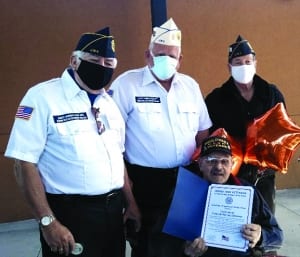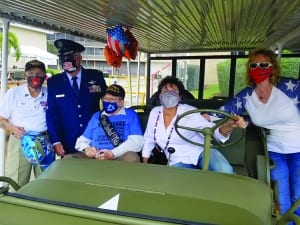By Larry Jasper
On February 6, Murray Zolkower turned 100-years-old. Two months ahead of the celebration, his daughter Francine decided to see if she could get people to send 100 birthday cards to him as a surprise. Between the efforts of National and the Department of Florida, as well as many Department and Post members, Zolkower received more than 500 cards. He also got letters from former President George W. Bush, Sen. Marco Rubio, Rep. Gus Bilirakis, and two former U.S. Surgeons General.

At Mission BBQ in Tampa, Murray Zolkower shows off the Centenarian Certificate from the JWV presented by the Department of Florida Commander Larry Jasper along with Jim Marenus and Jack Rudowsky of Post 373 in Tampa, FL
Mission BBQ, Zolkower’s favorite restaurant, hosted a surprise lunch for their special customer, as well as his children, friends, and three members of JWV. Two active-duty Army recruiters also made a surprise appearance along with a bag of goodies. During lunch, Department of Florida Commander Larry Jasper, assisted by Post 373 members Jack Rudowsky and Jim Marenus presented him with a JWV Centenarian Certificate.
On his actual birthday, February 6, Suncoast Region Veterans Village USA organized a parade in front of his home in Dunedin, Florida. The parade included restored military vehicles, a vehicle from Mission Barbecue, and other cars and trucks displaying congratulatory signs and American flags. The Dunedin Fire Department, Pinellas County Sheriff’s Office, Honor Flight of West Central Florida, and a retired Air Force Colonel who serves as an aide to Congressman Bilirakis also participated in the parade.
Zolkower joined JWV in 1946 when he returned home from World War II and is still co-commander of Post 409. He is one of the longest serving volunteers at Bay Pines VA Hospital in St. Petersburg.
Zolkower was surprised so many people came out and sent things to him for his birthday. He said it was the “greatest moment of my life.”
While attending Columbia College of Pharmacy in New York in 1938, a recruiter for the New York National Guard came on campus. He promised $15 a month for anyone who signed up and attended twice a month. That was a lot of money at the time, so Zolkower signed up. One year later, he was surprised when he had to report for active duty and disrupt his studies for one year. He spent that year at Camp Dix (now Fort Dix) in New Jersey. After being released he returned to Columbia only to have his studies again disrupted in 1943 when the Army called him back to active duty.
The Army had no need for a pharmacist, so they sent him to Colorado to train as a dental tech. Later the military sent him to Texas to train as a medic.
Zolkower found himself on Omaha Beach six weeks after D-Day. He said the beach was all cleaned up and very busy with supplies and personnel coming in. He was sent to an area near St. Lo, France, assigned to the 7th Convalescent Hospital, where they used large tents to treat troops who could return to duty.
In August 1944 he was in Paris assigned to a clearing company of the 45th Division as a Dental Tech, where he was evaluating soldiers with facial injuries.
Zolkower then moved to Etampes, France, where the Division set up in a captured German Hospital. The Army decided they did not need a Dental Tech there, so he became a medic assigned to the 92nd Mechanized Cavalry, 14th Division, sent to look for trouble close to the front.
Zolkower then got assigned to the 120th Medical Battalion in the 45th Infantry Division.
His unit fought their way through Nuremburg and Munich where they were billeted in a former SS barrack.

Col. Gerry Custin, aide to Rep. Gus Bilirakis, Murray Zolkower, Francine Wolf, and two friends.
On April 29, 1945, his unit was ordered to liberate Dachau. Zolkower said he didn’t want to go with the unit and see his fellow Jews dead or dying but was not given a choice. Zolkower said, “it was the worst thing I ever saw in my life.” He added that nice homes, like those in suburban Long Island, were lining the street leading to the front gate of the camp. He felt there was no way those living in those homes did not know the horrors taking place in the camp.
The war ended nine days later, but Zolkower could not return home right away. He remained with the military in Gars, Germany, where he helped set up a clinic to treat farmers who had sustained injuries. After two months, he returned to the United States.
Zolkower’s girlfriend, Lillian, wrote him every other day during his deployment. They were married in 1946 until her death in 2014. Zolkower returned to school and became a pharmacist in 1948. He still works as a pharmacist part-time.
Volume 75. Number 1. 2021

